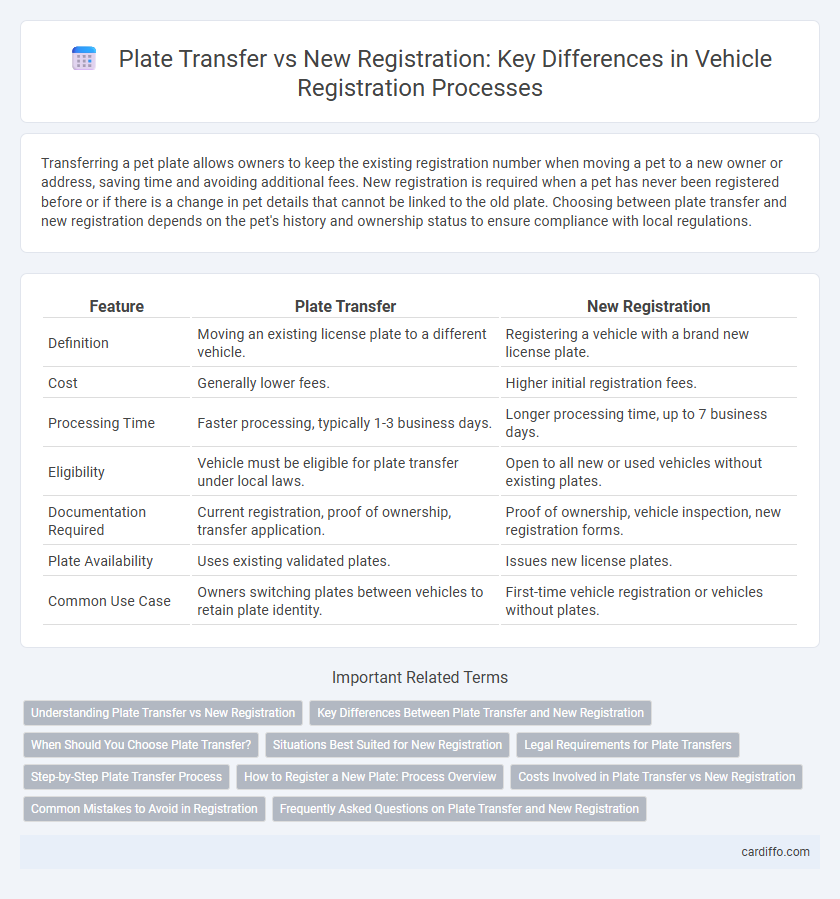Transferring a pet plate allows owners to keep the existing registration number when moving a pet to a new owner or address, saving time and avoiding additional fees. New registration is required when a pet has never been registered before or if there is a change in pet details that cannot be linked to the old plate. Choosing between plate transfer and new registration depends on the pet's history and ownership status to ensure compliance with local regulations.
Table of Comparison
| Feature | Plate Transfer | New Registration |
|---|---|---|
| Definition | Moving an existing license plate to a different vehicle. | Registering a vehicle with a brand new license plate. |
| Cost | Generally lower fees. | Higher initial registration fees. |
| Processing Time | Faster processing, typically 1-3 business days. | Longer processing time, up to 7 business days. |
| Eligibility | Vehicle must be eligible for plate transfer under local laws. | Open to all new or used vehicles without existing plates. |
| Documentation Required | Current registration, proof of ownership, transfer application. | Proof of ownership, vehicle inspection, new registration forms. |
| Plate Availability | Uses existing validated plates. | Issues new license plates. |
| Common Use Case | Owners switching plates between vehicles to retain plate identity. | First-time vehicle registration or vehicles without plates. |
Understanding Plate Transfer vs New Registration
Plate transfer allows vehicle owners to retain their existing license plates when changing vehicles, streamlining the registration process and preserving plate identity. New registration requires obtaining a completely new license plate, often involving additional fees and paperwork, typically necessary for first-time vehicle registration or when plate transfer is not applicable. Understanding the differences between plate transfer and new registration helps optimize time, cost, and compliance with local DMV regulations.
Key Differences Between Plate Transfer and New Registration
Plate transfer involves reassigning an existing vehicle registration number to another vehicle, conserving the original license plate while updating ownership details in the DMV system. New registration requires issuing a completely new license plate and registration document for a vehicle that has not been previously registered, involving fresh vehicle identification and fee submission. Key differences include cost, processing time, and the ability to retain a personalized or familiar plate number through plate transfer, unlike new registration which mandates a unique assignment.
When Should You Choose Plate Transfer?
Choose plate transfer when you want to retain your existing vehicle registration number for personalized or business reasons and avoid the hassle of remembering a new plate. This option is especially beneficial if the current plate holds sentimental value, brand identity, or recognition in your community. Plate transfer is also cost-effective compared to new registrations, saving fees associated with new plate issuance.
Situations Best Suited for New Registration
New registration is best suited for first-time vehicle owners or when purchasing a brand-new car directly from a dealership. It applies to vehicles that have never been registered or when transferring ownership across different states where plate transfer is not permitted. Situations involving custom or specialized plates often require new registration to meet specific state regulations and vehicle identification requirements.
Legal Requirements for Plate Transfers
Legal requirements for plate transfers mandate that the vehicle owner must ensure the license plates are clean, undamaged, and correctly registered under their name to avoid penalties. The registration process requires submitting proof of ownership, a valid identification document, and completing a formal transfer application within the state's motor vehicle department. Failure to adhere to these regulations can result in fines, invalid registration status, and potential legal complications.
Step-by-Step Plate Transfer Process
The step-by-step plate transfer process involves submitting a completed application form, proof of ownership, and the original vehicle registration to the motor vehicle department. After verifying the documents and paying the required fees, the department issues updated registration reflecting the transferred plates. This process is faster and cost-effective compared to new registration, which requires a full inspection and new vehicle documentation.
How to Register a New Plate: Process Overview
Registering a new plate involves submitting a completed application form, providing proof of vehicle ownership, and paying the required registration fees at the local DMV or authorized agency. Vehicle inspection and emissions testing may be necessary before issuance of the new license plate. After approval, the new plate is issued, and the vehicle's registration document is updated accordingly to reflect the new plate assignment.
Costs Involved in Plate Transfer vs New Registration
Plate transfer typically incurs lower costs than new vehicle registration because it avoids expenses related to issuing new plates and registration documents. New registration fees include charges for title processing, physical plate production, and administrative handling, which can significantly increase the total cost. Choosing plate transfer can reduce expenditure by maintaining existing plate numbers, minimizing fees associated with reissuance and administrative processes.
Common Mistakes to Avoid in Registration
Common mistakes during registration include confusing plate transfer with new registration, which leads to unnecessary fees and delays. Many applicants overlook verifying the eligibility of the plate for transfer, resulting in rejected applications. Ensuring accurate documentation and understanding the distinction between plate transfer and new registration streamlines the process and prevents administrative errors.
Frequently Asked Questions on Plate Transfer and New Registration
Plate transfer allows vehicle owners to retain their existing license plates when changing ownership or relocating, typically simplifying administrative processes and reducing fees compared to new registration. New registration requires obtaining a fresh license plate and registration document, often necessitating full vehicle inspection and payment of standard registration taxes and fees. Common FAQs address eligibility for plate transfer, required documents, fee differences, and timelines for processing both plate transfers and new registrations.
Plate Transfer vs New Registration Infographic

 cardiffo.com
cardiffo.com